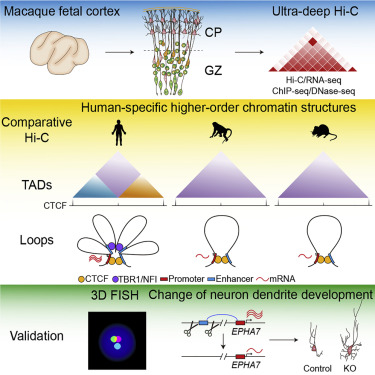
Elucidating the regulatory mechanisms of human brain evolution is essential to understanding human cognition and mental disorders. We generated multi-omics profiles and constructed a high-resolution map of 3D genome architecture of rhesus macaque during corticogenesis. By comparing the 3D genomes of human, macaque, and mouse brains, we identified many human-specific chromatin structure changes, including 499 topologically associating domains (TADs) and 1,266 chromatin loops. The human-specific loops are significantly enriched in enhancer-enhancer interactions, and the regulated genes show human-specific expression changes in the subplate, a transient zone of the developing brain critical for neural circuit formation and plasticity. Notably, many human-specific sequence changes are located in the human-specific TAD boundaries and loop anchors, which may generate new transcription factor binding sites and chromatin structures in human. Collectively, the presented data highlight the value of comparative 3D genome analyses in dissecting the regulatory mechanisms of brain development and evolution.
Read More:https://doi.org/10.1016/j.cell.2021.01.001